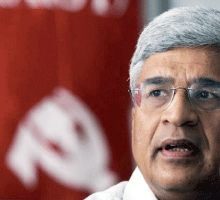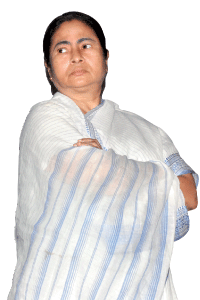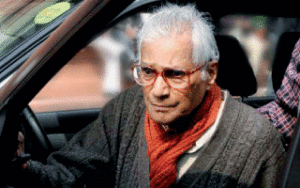Look back at the exhilarating yet chaotic scenes after Lok Sabha elections in 1996. The Congress had been handed a resounding defeat and a coalition headed by Atal Bihari Vajpayee of the BJP lasted a mere 13 days. As non Congress and non BJP parties and leaders huddled together to form a government and nominate a prime minister, the name of the late Jyoti Basu kept cropping up frequently. After much debate, the party bosses at CPI (M) vetoed the idea of Jyoti Basu as a prime minister. Many party leaders , in hindsight, call it a historic blunder. That was perhaps the first and last time a Marxist came close to becoming the prime minister of India.
Now remember the tumultuous scenes after the Left withdrew support to the first UPA government in 2008 over the Indo-US nuclear deal. Prior to the 2009 Lok Sabha elections, the media was full of CPM party leaders Prakash Karat and Sitaram Yecchury. They were supposed to be kingpins and kingmakers in the aftermath of the elections. Nobody talked about Narendra Modi as a prime ministerial candidate. Mayawati and Mulayam Singh Yadav were supposed to be serious contenders. Why, this magazine even had Sitaram Yecchury on the cover as a possible prime minister of the country.
 Look at the political scenario in the country today as we approach yet another Lok Sabha election. Love him or hate him, you can’t stop talking about Narendra Modi as a potential candidate for prime minister. Mayawati and Mulayam Singh Yadav still nurture their ambitions. But who is talking about Prakash Karat and Sitaram Yecchury? It appears as if the mainstream media has completely written off the Left Front as players of any consequence in Indian politics. In fact, it is battling hard to retain its last bastion in Tripura, where campaigning for Assembly elections is on in full swing.
Look at the political scenario in the country today as we approach yet another Lok Sabha election. Love him or hate him, you can’t stop talking about Narendra Modi as a potential candidate for prime minister. Mayawati and Mulayam Singh Yadav still nurture their ambitions. But who is talking about Prakash Karat and Sitaram Yecchury? It appears as if the mainstream media has completely written off the Left Front as players of any consequence in Indian politics. In fact, it is battling hard to retain its last bastion in Tripura, where campaigning for Assembly elections is on in full swing.
Says Amrito Maiti of the Revolutionary Socialist Party: “Yes the craziness towards our movement has decreased a lot, but it doesn’t mean that people have totally banned Left ideology. It’s really a posititive sign that just within two years of Mamata’s, tenure we have already started getting responses from the mass.”
The fall from the heady days of 1996 when Jyoti Basu was a serious contender for the top job has been quite precipitous. Most analysts are being compelled to ask: What’s Left? If you go by how mainstream media deals with parties and issues, it is clear that the Left in India seems to be in terminal decline. The real shock for the Left came during the 2009 Lok Sabha elections. The CPM lost 27 seats and the CPI lost 6 seats. From controlling close to 60 Lok Sabha members, the Left was virtually reduced to a rump with control over barely 30 members. Then came even more electoral shocks. In Kerala, the Left lost narrowly to a coalition led by the Congress. Worse, the unchallenged 34 year old reign of the Left Front came to a humiliating end in West Bengal where it was decimated by Mamata Bannerjee. Now, Tripura is the last state in which the Left Front runs a government. This is indeed a far cry from the heady days after independence when the Left won the first democratically contested elections in the world in the 1950s. The Left has also steadily lost ground in its other bastion – the trade unions. There was a time when Left oriented trade unions were in complete command in the industrial heartland of Maharashtra. It is the Shiv Sena that has taken over there. Even at the national level, the Bhartiya Mazdoor Sangh, which claims affiliation to the BJP, now claims to command more members and cadres than the Leftist trade unions.
 What went wrong with the promise shown by the Left? After all, in a poor country like India, the Left, with its commitment to the poor and the working class should have held a natural advantage. It should have been a natural alternative to the Congress party since most Indian voters seemed to show hardly any liking for right wing Hindu parties like the Jan Sangh. In fact, the CPI was a far more ‘national’ party than the Jan Sangh. It had influence and electoral clout in states ranging from Bengal to Andhra Pradesh to Bihar to Punjab to Maharashtra to Kerala to Odisha to Tamil Nadu. It was the first non Congress political party to form a state government in Kerala. In fact, when the then Prime Minister Indira Gandhi adopted extreme Left economic policies like nationalisation, it looked as if the ultimate triumph of the Left in India was but a matter of time.
What went wrong with the promise shown by the Left? After all, in a poor country like India, the Left, with its commitment to the poor and the working class should have held a natural advantage. It should have been a natural alternative to the Congress party since most Indian voters seemed to show hardly any liking for right wing Hindu parties like the Jan Sangh. In fact, the CPI was a far more ‘national’ party than the Jan Sangh. It had influence and electoral clout in states ranging from Bengal to Andhra Pradesh to Bihar to Punjab to Maharashtra to Kerala to Odisha to Tamil Nadu. It was the first non Congress political party to form a state government in Kerala. In fact, when the then Prime Minister Indira Gandhi adopted extreme Left economic policies like nationalisation, it looked as if the ultimate triumph of the Left in India was but a matter of time.
But those dreams and hopes look like a chimera in contemporary India. It would be a surprise for everybody if the Left manages to significantly improve its tally in the forthcoming Lok Sabha elections. The obvious thing to ask is what exactly happened with the Left parties and the Left movement in the country. Both in terms of ideological influence and electoral success. The first thing to note is that the collapse of the Soviet Union led to a universal crisis of credibility for the Left throughout the world. As long as the Soviet Union stayed intact and appeared to be a formidable adversary to the United States, the Left always had a kind of romantic appeal. But the collapse of the Soviet Union revealed fundamental fault lines in the world of communism and Marxism, fault lines that could not be papered over by slogans and propaganda. Of course, as the accompanying article by colleague Saurabh Shahi shows, the Left still displays resilience and still attracts support across the world. But there can be no doubt that it is no longer considered to be a serious alternative to capitalism and capitalist democracy.
 In India, the decline of the Left had started much before the collapse of the Soviet Union. One of the key reasons was a kind of suicidal fragmentation of the Left parties and movement across India. Till the 1960s, the CPI was a monolith that dominated the Left movement and discourse in India, including electoral politics. But in the aftermath of India’s humiliation by the Chinese military in 1962, the cleavages in communist India were very clear. Eventually, the CPI split and resulted in the formation of two parties – the Communist Party of India (CPI) and the Communist Party of India (Marxist), better known nowadays as the CPM. Since the 1970s, it is the CPM that has been the dominant communist party in the country with the CPI playing second fiddle. This was not the only split. More ideologically aggressive factions formed their own versions of Marxist-Leninist parties and the Left no longer presented a united front. A large number of Marxists turned armed revolutionaries and launched the Naxalite movement. Naxalite movements and outfits have flourished in states like Andhra Pradesh, Odisha, Madhya Pradesh, Maharashtra, Bihar, West Bengal, Jharkhand and Odisha. In fact, in many parts of central and eastern India, these armed Leftists virtually run parallel governments of their own. Ironically, even as the mainstream Left has lost ideological influence and electoral clout, it is the Naxalites that have proven to be more potent, more resilient and more durable. But then, even those romantically inclined towards the Left know that the Naxalite movement will not succeed in its aim of liberating the masses and overthrowing the Indian State.
In India, the decline of the Left had started much before the collapse of the Soviet Union. One of the key reasons was a kind of suicidal fragmentation of the Left parties and movement across India. Till the 1960s, the CPI was a monolith that dominated the Left movement and discourse in India, including electoral politics. But in the aftermath of India’s humiliation by the Chinese military in 1962, the cleavages in communist India were very clear. Eventually, the CPI split and resulted in the formation of two parties – the Communist Party of India (CPI) and the Communist Party of India (Marxist), better known nowadays as the CPM. Since the 1970s, it is the CPM that has been the dominant communist party in the country with the CPI playing second fiddle. This was not the only split. More ideologically aggressive factions formed their own versions of Marxist-Leninist parties and the Left no longer presented a united front. A large number of Marxists turned armed revolutionaries and launched the Naxalite movement. Naxalite movements and outfits have flourished in states like Andhra Pradesh, Odisha, Madhya Pradesh, Maharashtra, Bihar, West Bengal, Jharkhand and Odisha. In fact, in many parts of central and eastern India, these armed Leftists virtually run parallel governments of their own. Ironically, even as the mainstream Left has lost ideological influence and electoral clout, it is the Naxalites that have proven to be more potent, more resilient and more durable. But then, even those romantically inclined towards the Left know that the Naxalite movement will not succeed in its aim of liberating the masses and overthrowing the Indian State.
 The other big body blow to the fortunes of the Left was delivered about three decades ago when a series of events and policies led to the rise of communal politics in India. The year 1986 can be termed as the defining one in this process. In that year, the government headed by the late Rajiv Gandhi overturned a Supreme Court verdict that made it mandatory for Muslim men to pay maintenance to divorced wives. This is the now infamous Shah Bano case. This decision was seen as a meek and abject surrender to radical Muslim bodies and was taken despite strong objections from liberal Muslims. The same year, the government allowed hard line Hindu outfits to lay claim to the Babri Masjid as the birthplace of Lord Ram. This decision too was seen as a kind of surrender to hard line Hindu radicals and was taken despite strong objections from liberal Hindus. These two decisions sparked off a series of events that eventually led to the demolition of the Babri Masjid in 1992 and the subsequent emergence of the BJP as a serious contender for power. In 1984, the BJP had managed to win barely 4 seats in the Lok Sabha. By 1996, the tally had gone well beyond 100 and the party actually formed a short lived 13 day government at the centre. The Left was no longer a natural alternative to a moth eaten Congress. The BJP had taken over that role even as it expanded its presence across India. The growing gap between the Left and the BJP was visible in the 2009 Lok Sabha elections when both were decisively rejected by the voters. The vote share of the BJP was close to 19 per cent while that of the CPM was a little above 5 per cent. More important, while the Left struggles to preserve its last bastion in Tripura, the BJP rules in states like Chattisgarh, Madhya Pradesh, Karnataka, Gujarat and Punjab. Yet another irony is: firebrand socialists of yore with disrinctively left leanings, like George Fernandes, became part of a coalition led by the BJP. This was something that even the marxists couldnt have imagined back in their heydays in the 1970s.
The other big body blow to the fortunes of the Left was delivered about three decades ago when a series of events and policies led to the rise of communal politics in India. The year 1986 can be termed as the defining one in this process. In that year, the government headed by the late Rajiv Gandhi overturned a Supreme Court verdict that made it mandatory for Muslim men to pay maintenance to divorced wives. This is the now infamous Shah Bano case. This decision was seen as a meek and abject surrender to radical Muslim bodies and was taken despite strong objections from liberal Muslims. The same year, the government allowed hard line Hindu outfits to lay claim to the Babri Masjid as the birthplace of Lord Ram. This decision too was seen as a kind of surrender to hard line Hindu radicals and was taken despite strong objections from liberal Hindus. These two decisions sparked off a series of events that eventually led to the demolition of the Babri Masjid in 1992 and the subsequent emergence of the BJP as a serious contender for power. In 1984, the BJP had managed to win barely 4 seats in the Lok Sabha. By 1996, the tally had gone well beyond 100 and the party actually formed a short lived 13 day government at the centre. The Left was no longer a natural alternative to a moth eaten Congress. The BJP had taken over that role even as it expanded its presence across India. The growing gap between the Left and the BJP was visible in the 2009 Lok Sabha elections when both were decisively rejected by the voters. The vote share of the BJP was close to 19 per cent while that of the CPM was a little above 5 per cent. More important, while the Left struggles to preserve its last bastion in Tripura, the BJP rules in states like Chattisgarh, Madhya Pradesh, Karnataka, Gujarat and Punjab. Yet another irony is: firebrand socialists of yore with disrinctively left leanings, like George Fernandes, became part of a coalition led by the BJP. This was something that even the marxists couldnt have imagined back in their heydays in the 1970s.
Says Khsiti Goswami, RSP: “But the ground reality is not exactly the same so far. Rather, be it Left or others like Congress or BJP, nobody has that much capacity at least to have some control over such coalition tenure. For the time being, it’s either Congress or BJP being considered as major party of the nation. But at state level the equation has always been different.”
 The third visible reason for the seemingly terminal decline of the Left is the consistent rise of regional parties across India. In states where the BJP is weak, it is the regional parties that have taken over as alternatives to the Congress. Bihar, Odisha, Andhra Pradesh, Tamil Nadu, Maharashtra, Uttar Pradesh and even Kerala have seen the sustained rise and growth of regional parties. In many of these states, the Left had a solid vote bank and a strong electoral as well as ideological influence once upon a time. It is a matter of time before a new state of Telengana is carved out of Andhra Pradesh. The irony is, it is the communists who first led a sustained a successful agitation for the rights of the poor in the Telengana region. It is extremely doubtful if Telengana voters will give them any rewards for their efforts. There are many in the Left who complain that the Indian electorate hasn’t matured beyond caste and identity politics and has thus not been able to see that it is the Left that has consistently fought for the poor and the oppressed. But then that could well be a case of sour grapes.
The third visible reason for the seemingly terminal decline of the Left is the consistent rise of regional parties across India. In states where the BJP is weak, it is the regional parties that have taken over as alternatives to the Congress. Bihar, Odisha, Andhra Pradesh, Tamil Nadu, Maharashtra, Uttar Pradesh and even Kerala have seen the sustained rise and growth of regional parties. In many of these states, the Left had a solid vote bank and a strong electoral as well as ideological influence once upon a time. It is a matter of time before a new state of Telengana is carved out of Andhra Pradesh. The irony is, it is the communists who first led a sustained a successful agitation for the rights of the poor in the Telengana region. It is extremely doubtful if Telengana voters will give them any rewards for their efforts. There are many in the Left who complain that the Indian electorate hasn’t matured beyond caste and identity politics and has thus not been able to see that it is the Left that has consistently fought for the poor and the oppressed. But then that could well be a case of sour grapes.
As if all this were not enough, the Left has now also been a hotbed of internal wrangling and fratricidal politicking. The most damaging manifestation of this is visible in the state of Kerala where two bitterly opposed factions are virtually destroying the CPM. One faction is led to by the popular former chief minister VS Achutanandan who is perceived to be a man of integrity, albeit a cranky one at that. The other faction is led by the party apparatchik Pinnari Vijayan which has consistently tried to undermine the popularity and electoral charm of VS. In fact, in his suicidal drama, the CPM resembles the BJP where back room leaders wage war against leaders with electoral appeal.
Our colleague in Mumbai travelled about 250 kilometers to the village of Karnajigaon where the father of the communist movement of India, SA Dange was born. What he saw and heard there while trying to find out what legacy the legendary communist leader has left behind reveals a lot about the bleak future of the Left in this country. Hardly anybody he encountered had heard of the name SA Dange. Nobody seemed aware that he was a towering political figure of India. It was eventually a police constable and an enthusiastic auto driver who directed our colleague to the outskirts of Karanjigaon. Initially, our colleague was met with hostile stares and silence when he started asking questions about Dange and his family. The villagers opened up only after they were convinced that he was not a member of the Dange family. One villager took him to the ruins of the Dange home, flanked by a crumbling temple right on the banks of Godavari river. According to him, the daughter of Dange, Rosa Dange who was an MP came to the village in 1965 and took away a revered idol of Lord Shiva from the temple with false assurances that it was meant for the welfare of the villagers. She wasn’t seen again and the village harbors no love for the Danges. It is impossible to verify how true this apocryphal story is. But one fact is clear: the village is now a stronghold of the Shiv Sena.
























